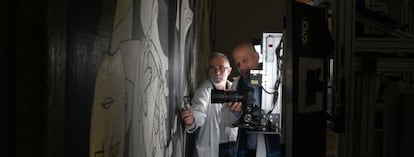The ultimate picture of ‘Guernica’
A robotic imaging machine is creating thousands of high-res photos of Picasso’s most famous work The aim is ascertain the state of the masterpiece


In the intense and eventful life of Guernica, all that was missing was a face-off with an android. But then again, if there is an iconic mural capable of dealing with any kind of company, no matter how modern or sophisticated, that would be Picasso’s famous cry against the horrors of war.
Despite its delicate health, Guernica seems timeless and ageless. That is why the arrival of Pablito, the nickname given to the robot now analyzing the painting in microscopic detail, does not really come as a shock.
The new resident of the Reina Sofía art museum in Madrid will share a room with the lord of the house until June, when it completes its comprehensive sweep of digital imaging, which will reveal all there is to know about this universal symbol, which still preserves the mystery of wounds that do not heal.
The robot, which takes around 1,000 photographs for every eight hours of work, will produce up to 24,000 images for every macrophoto of the 27-square-meter mural.
“And we will make at least five [macrophotos],” says Jorge García Gómez-Tejedor, chief of the museum’s preservation and restoration department. “Two in infrared, one in ultraviolet, one in visible light, a multispectral one... In the end, all those photographs will overlap to create one final image with which we can conduct all the studies we want, and will let us investigate as never before the material history of the painting.”
This “sewing” process will eventually allow for unprecedented studies of the mural.
Until the summer, the robot will be working at night to avoid bothering museumgoers, who can read an information panel to find out exactly what this 10-meter-long, five-meter-high, 1.5-ton creature is doing here.
The panel does not, however, give out the information that the robot was created in the Basque town of Hernani, at a factory that would rather not disclose its name. Construction was funded by the Telefónica Foundation, which declined to say how much it cost, either, although some sources place the price tag at around 300,000 euros.
Made of aluminum, iron and steel, the robot works as an automated mechanical system running along three axes. Its movements are directed by computer software (or manually if necessary), and it is accurate to 25 microns, making it one of the most precise robot cameras on the market.
The machine is the brainchild of the museum’s preservation and restoration department, which has spent the last few years developing a device purpose-built for Guernica.
“It was manufactured specifically for the painting, and is made to measure and tailored to meet its needs,” explains Humberto Durán, a restorer who specializes in computer applications and oversaw the development of the robot’s operating system.
Every night, Pablito will be left alone with Guernica to pick up on every one of its imperfections — from cracks and tears, to wax and resin buildup. In many cases, the existence of such faults is already known, but they will now be recorded in an oversized digital image that will never age.
“If any glitches occur at night, the machine will stop,” says Durán. Although the making of the painting is well documented through the photographs that Dora Maar took at the time of its creation, the robot will record all the changes made to the picture by Picasso as he went along.
The goal, say museum managers, is not the painting’s restoration, nor to prove what most experts already agree on — that the power of its artistic value is inversely proportional to its physical fragility, and that moving it could cause serious damage.
The origin of the project lies in research conducted in 1998, back when the museum director was José Guirao, who tasked restoration chief Pilar Sedano Espín with a detailed study about the state of Guernica. Her successor, Jorge García Gómez-Tejedor, still remembers that job, in which he participated along with 30 international experts.
“Those of us who know the painting also know that any kind of stress could easily tear the canvas. Moving it must be avoided at all costs. This is something that all professionals recognize. That is why the goal of this study is not to prove that which is already known, but to get to know the painting better. Although, of course, we could now estimate down to the last micron the kind of damage it would sustain, were it to be moved or transferred.”
The Prado Museum, also in Madrid, has expressed an interest in getting the painting back, after displaying it for 10 years following its return from New York. In January, Prado director Miguel Zugaza said that “our grandchildren will view Guernica at the Prado.” But it looks like it’s staying put. In 1997, the Reina Sofía refused to loan it to the Guggenheim Bilbao for its inauguration, on the grounds that it was too risky to move it.
Guernica traveled on 50 occasions before finally resting at the Reina Sofía in 1992. That is to say, it was rolled up and unrolled 100 times. In the late 1950s, Picasso personally asked MoMA for the painting to stop traveling, as he was very concerned about its state. Guernica only traveled once again, when it returned to Spain in 1981. But the restoration techniques applied at New York’s Museum of Modern Art added new problems to the painting’s original ones. The hot wax applied to the back of it for protection has become one of its worst enemies. Among other things, it has made Guernica much heavier than it should be, while the wax has impregnated the canvas to the point that it has seeped out through the paint in places.
In 1998, a team of experts reached emphatic conclusions. Konrad Laudenbacher, chief curator of Munich’s Neue Pinakothek, said that not even the most modern technology would prevent damage to the painting were it to be moved: “It would be torture.”
Enrich Gantzert Castrillo, of Frankfurt’s Museum Für Moderne Kunst, held that cultural legacies should be preserved over the spectacle factor. And the main thing about Guernica was to preserve it for the coming generations.
All those conclusions were the fruit of painstaking work by people like José Loren, who spent weeks perched on top of scaffolding, holding a 35mm slide camera in his hands. These days, this specialist in restoration photography stares at the computer screen, which tracks the work of a robot that has replaced his own fingers.
“In 1998 we took 3,000 photographs in three weeks,” he says with a shrug. “We set up and took down the scaffold every single day.”
Loren talks about Guernica with that phony distance with which parents talk about their favorite children: “A tough job? A painting with mussel shells on canvas is a tough job. Everyone is interested in this particular painting — although after all, it is just oil on canvas.”
Tu suscripción se está usando en otro dispositivo
¿Quieres añadir otro usuario a tu suscripción?
Si continúas leyendo en este dispositivo, no se podrá leer en el otro.
FlechaTu suscripción se está usando en otro dispositivo y solo puedes acceder a EL PAÍS desde un dispositivo a la vez.
Si quieres compartir tu cuenta, cambia tu suscripción a la modalidad Premium, así podrás añadir otro usuario. Cada uno accederá con su propia cuenta de email, lo que os permitirá personalizar vuestra experiencia en EL PAÍS.
¿Tienes una suscripción de empresa? Accede aquí para contratar más cuentas.
En el caso de no saber quién está usando tu cuenta, te recomendamos cambiar tu contraseña aquí.
Si decides continuar compartiendo tu cuenta, este mensaje se mostrará en tu dispositivo y en el de la otra persona que está usando tu cuenta de forma indefinida, afectando a tu experiencia de lectura. Puedes consultar aquí los términos y condiciones de la suscripción digital.
Últimas noticias
Reinhard Genzel, Nobel laureate in physics: ‘One-minute videos will never give you the truth’
Pinochet’s victims grapple with José Antonio Kast’s rise in Chile
From digital curfews to blocking apps: How technology experts protect their children online
Why the price of coffee has skyrocketed: from Brazilian plantations to specialty coffee houses
Most viewed
- Pablo Escobar’s hippos: A serious environmental problem, 40 years on
- Why we lost the habit of sleeping in two segments and how that changed our sense of time
- Trump’s obsession with putting his name on everything is unprecedented in the United States
- Charles Dubouloz, mountaineering star, retires at 36 with a farewell tour inspired by Walter Bonatti
- The Florida Keys tourist paradise is besieged by immigration agents: ‘We’ve never seen anything like this’








































